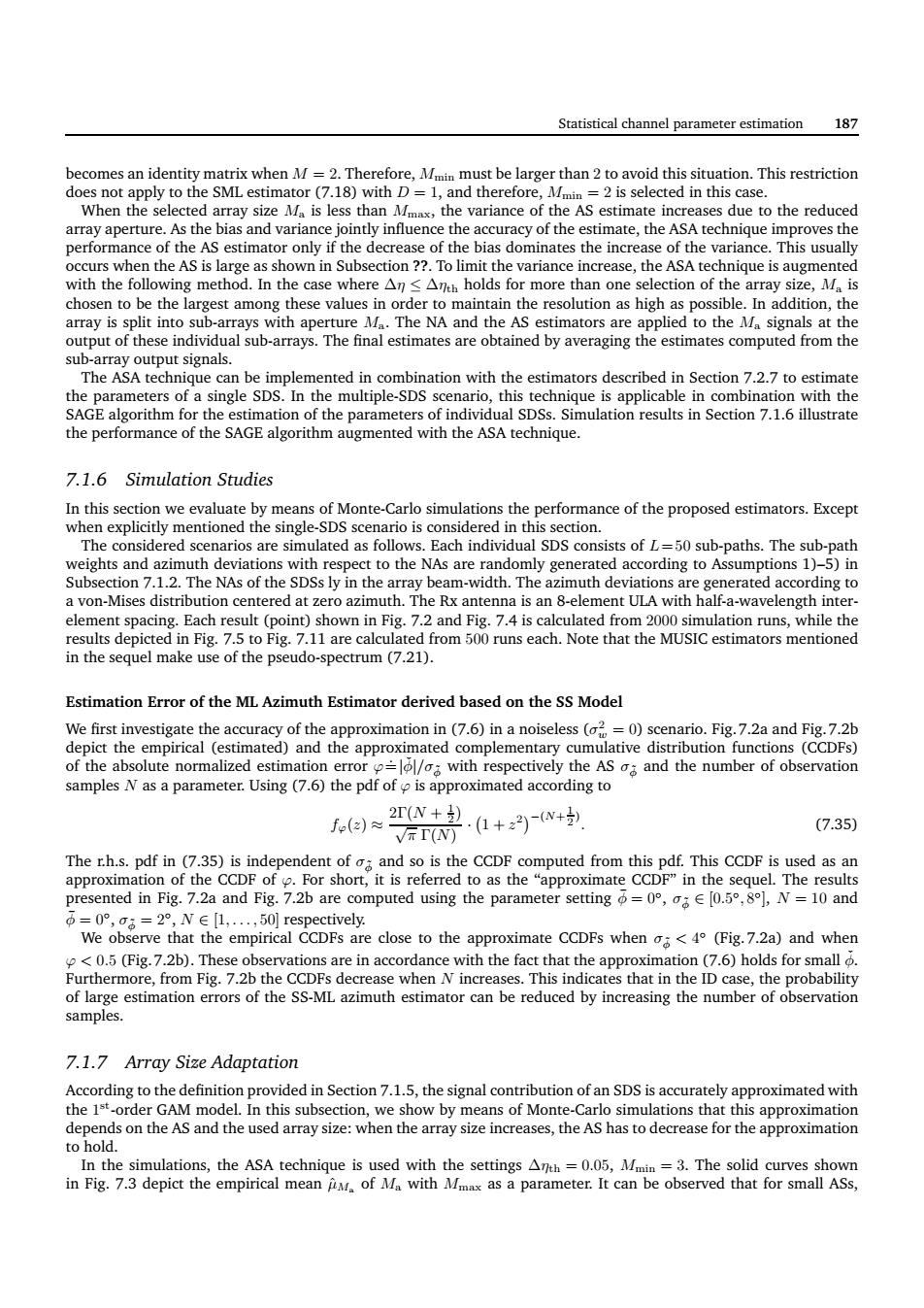正在加载图片...

Statistical channel parameter estimation 187 s an iden fore.M chosen to be the am the high as possible.In addition.the implemented wh the performance of the SAGE algorithm augmented with the ASA technique. 7.1.6 Simulation Studies Sughts and a von-Mises distribution centered at zero azmuth.TheRx antenna is an 8-element ULA with half-a-wavelength inter in the sequel make use of the pseudo-spectrum (7.21). Estimation frror of the mi Azimuth estimator derived based on the ss model of the absolute normalized estimation error with respectively the As and the number of observation samples N as a parameter.Using (7.6)the pdf ofis approximated according to e+ (7.35) rdin and b are compured using the paramerer sinNand eclose to the ate CCDFs when(Fig7.2a)and wher of large stimtion of the SS-MLazmuth estimator can be reduced by increasing the number of observation 7.1.7 Array Size Adaptation According to the definition provided in Section 7.1.5,the signal contribution of an SDS is accurately approximated with Statistical channel parameter estimation 187 becomes an identity matrix when M = 2. Therefore, Mmin must be larger than 2 to avoid this situation. This restriction does not apply to the SML estimator (7.18) with D = 1, and therefore, Mmin = 2 is selected in this case. When the selected array size Ma is less than Mmax, the variance of the AS estimate increases due to the reduced array aperture. As the bias and variance jointly influence the accuracy of the estimate, the ASA technique improves the performance of the AS estimator only if the decrease of the bias dominates the increase of the variance. This usually occurs when the AS is large as shown in Subsection ??. To limit the variance increase, the ASA technique is augmented with the following method. In the case where ∆η ≤ ∆ηth holds for more than one selection of the array size, Ma is chosen to be the largest among these values in order to maintain the resolution as high as possible. In addition, the array is split into sub-arrays with aperture Ma. The NA and the AS estimators are applied to the Ma signals at the output of these individual sub-arrays. The final estimates are obtained by averaging the estimates computed from the sub-array output signals. The ASA technique can be implemented in combination with the estimators described in Section 7.2.7 to estimate the parameters of a single SDS. In the multiple-SDS scenario, this technique is applicable in combination with the SAGE algorithm for the estimation of the parameters of individual SDSs. Simulation results in Section 7.1.6 illustrate the performance of the SAGE algorithm augmented with the ASA technique. 7.1.6 Simulation Studies In this section we evaluate by means of Monte-Carlo simulations the performance of the proposed estimators. Except when explicitly mentioned the single-SDS scenario is considered in this section. The considered scenarios are simulated as follows. Each individual SDS consists of L= 50 sub-paths. The sub-path weights and azimuth deviations with respect to the NAs are randomly generated according to Assumptions 1)–5) in Subsection 7.1.2. The NAs of the SDSs ly in the array beam-width. The azimuth deviations are generated according to a von-Mises distribution centered at zero azimuth. The Rx antenna is an 8-element ULA with half-a-wavelength interelement spacing. Each result (point) shown in Fig. 7.2 and Fig. 7.4 is calculated from 2000 simulation runs, while the results depicted in Fig. 7.5 to Fig. 7.11 are calculated from 500 runs each. Note that the MUSIC estimators mentioned in the sequel make use of the pseudo-spectrum (7.21). Estimation Error of the ML Azimuth Estimator derived based on the SS Model We first investigate the accuracy of the approximation in (7.6) in a noiseless (σ 2 w = 0) scenario. Fig.7.2a and Fig.7.2b depict the empirical (estimated) and the approximated complementary cumulative distribution functions (CCDFs) of the absolute normalized estimation error ϕ .=|φˇ|/σφ˜ with respectively the AS σφ˜ and the number of observation samples N as a parameter. Using (7.6) the pdf of ϕ is approximated according to fϕ(z) ≈ 2Γ(N + 1 2 ) √ π Γ(N) · 1 + z 2 −(N+ 1 2 ) . (7.35) The r.h.s. pdf in (7.35) is independent of σφ˜ and so is the CCDF computed from this pdf. This CCDF is used as an approximation of the CCDF of ϕ. For short, it is referred to as the “approximate CCDF” in the sequel. The results presented in Fig. 7.2a and Fig. 7.2b are computed using the parameter setting φ¯ = 0◦ , σφ˜ ∈ [0.5 ◦ , 8 ◦ ], N = 10 and φ¯ = 0◦ , σφ˜ = 2◦ , N ∈ [1, . . . , 50] respectively. We observe that the empirical CCDFs are close to the approximate CCDFs when σφ˜ < 4 ◦ (Fig.7.2a) and when ϕ < 0.5 (Fig.7.2b). These observations are in accordance with the fact that the approximation (7.6) holds for small φˇ. Furthermore, from Fig. 7.2b the CCDFs decrease when N increases. This indicates that in the ID case, the probability of large estimation errors of the SS-ML azimuth estimator can be reduced by increasing the number of observation samples. 7.1.7 Array Size Adaptation According to the definition provided in Section 7.1.5, the signal contribution of an SDS is accurately approximated with the 1 st-order GAM model. In this subsection, we show by means of Monte-Carlo simulations that this approximation depends on the AS and the used array size: when the array size increases, the AS has to decrease for the approximation to hold. In the simulations, the ASA technique is used with the settings ∆ηth = 0.05, Mmin = 3. The solid curves shown in Fig. 7.3 depict the empirical mean µˆMa of Ma with Mmax as a parameter. It can be observed that for small ASs